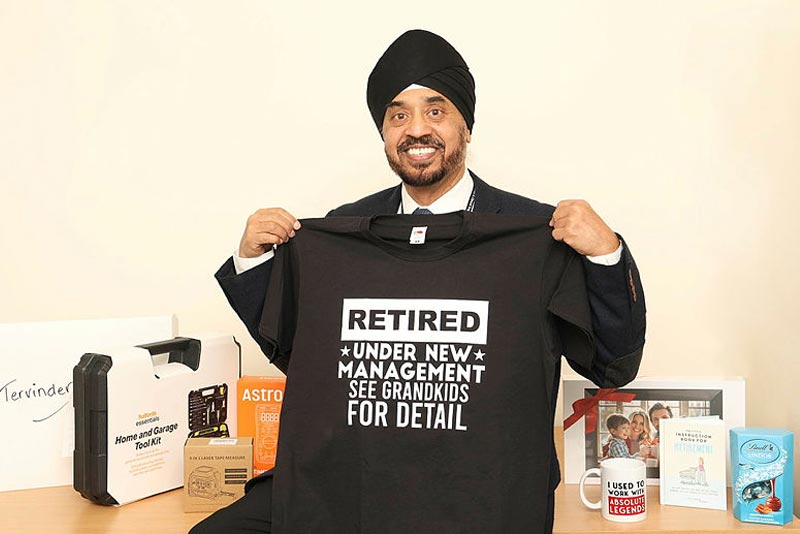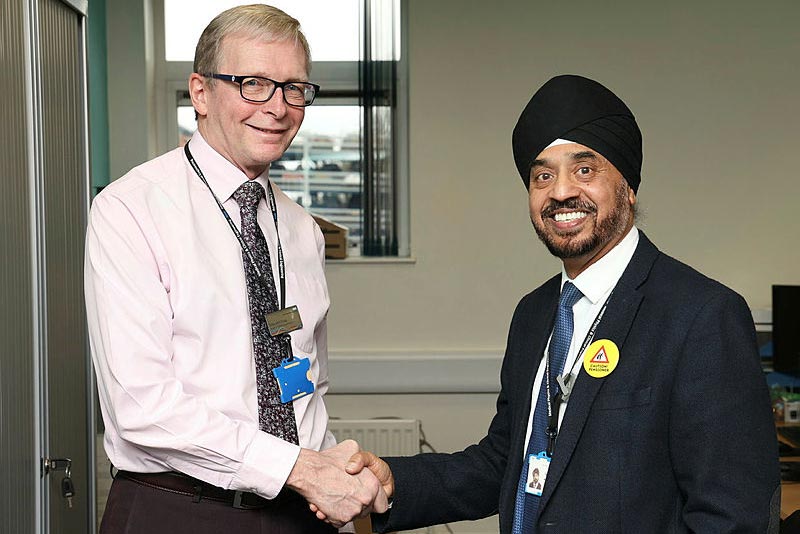Ta-ra Tervinder
Date of release: 7 January 2025
A “perfectionist” scientist behind the radiation treatment of thousands of cancer patients is hanging up his gown after four decades’ service in Wolverhampton.

Tervinder with a t-shirt presented to him and his gifts
Tervinder Matharu, 66, Consultant Clinical Scientist who led the Radiotherapy Physics service at The Royal Wolverhampton NHS Trust (RWT), has retired after 40 years in the role - 42 years to the day he started in the NHS.
Based at New Cross Hospital, he led approximately 20 Radiotherapy-scientific staff who design radiation treatment, returning for a send-off from colleagues today.
During his long career at RWT, he liaised closely with Consultant Clinical Oncologists and Radiographers who deliver radiation therapy, ensuring machines deliver the correct amount of radiation.
After graduating in Biomedical Electronics, the father of two joined the Medical Physics Department at Churchill Hospital in Oxford in 1983.
Tervinder started at Wolverhampton’s former Royal Hospital on 29 October 1984 and remained in the department.
Malcolm Foley, Head of Medical Physics & Clinical Engineering at RWT and Tervinder’s manager, said: “His greatest achievement was overseeing the huge technology changes that Radiotherapy treatments have undergone.
“He’s very modest but his biggest satisfaction is knowing he’s contributed to the cancer treatment of thousands of patients.
“He’s a perfectionist and very focused on every patient having the best radiation treatment plan – an ethos all his staff admirably follow.
“He often stayed late and worked long hours, putting the patient before himself.”
Malcolm added: “Tervinder started when Radiotherapy treatments were very basic compared to today.

Tervinder and Malcolm Foley (left)
“There was one radiation planning computer that could model one patient at a time.
“The equipment delivering the x-radiation – of which there were two – was very basic.
“Now the computer systems allow more patient-specific treatments to be generated, and multiple patients can be planned at the same time by different operators.
“There are now four computer-controlled x-radiation machines allowing a full range of shapes and sizes of radiation fields to deliver customised treatments.”
Tervinder’s perfectionism even spilled into Christmas celebrations, as Malcolm recalled.
“At the old Royal Hospital, wards used to enter competitions to ‘dress up and decorate’ their areas,” he added.
“One year we followed the theme of Wizard of Oz. The spiral of the yellow brick road started in what was the Medical Physics waiting room and went through to Radiotherapy.
“Tervinder insisted the spiral was perfect, which frustrated – in a nice way – other staff at how many changes had to be made!”
Tervinder now wants to spend more time with wife Ranjit and daughters Gurpreet, 33, and Maiya, 29, a Pharmacist at RWT, especially as his second grandson is due next month.
“Working at RWT has been like being in a family,” said Tervinder. “I have thoroughly enjoyed working together as a team, learning from each other and supporting each other.
“Other highlights have been introducing new techniques, meeting technical challenges and developing techniques for individual patients, as well as teaching and training staff.”
ENDS
- For further information, please call Tim Nash on 07714 741097 or email tim.nash2@nhs.net

